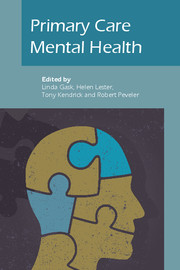Book contents
- Frontmatter
- Contents
- List of figures, tables and boxes
- List of contributors
- Preface
- Part I Conceptual basis and overarching themes
- Part II Clinical issues
- 8 Depression
- 9 Suicide and self-harm
- 10 Anxiety
- 11 Medically unexplained symptoms
- 12 Mental health problems in older people
- 13 Perinatal mental health
- 14 Child and adolescent mental health
- 15 Psychosis
- 16 Emergencies in primary care
- 17 Substance misuse
- 18 Management of alcohol problems
- 19 Eating disorders
- 20 Physical health of people with mental illness
- 21 Ethnic minorities
- 22 Asylum seekers and refugees
- 23 Sexual problems
- Part III Policy and practice
- Part IV Reflective practice
- Epilogue: Racing pigeons and rolling rocks: reflections on complex problems in primary care
- Index
10 - Anxiety
from Part II - Clinical issues
Published online by Cambridge University Press: 02 January 2018
- Frontmatter
- Contents
- List of figures, tables and boxes
- List of contributors
- Preface
- Part I Conceptual basis and overarching themes
- Part II Clinical issues
- 8 Depression
- 9 Suicide and self-harm
- 10 Anxiety
- 11 Medically unexplained symptoms
- 12 Mental health problems in older people
- 13 Perinatal mental health
- 14 Child and adolescent mental health
- 15 Psychosis
- 16 Emergencies in primary care
- 17 Substance misuse
- 18 Management of alcohol problems
- 19 Eating disorders
- 20 Physical health of people with mental illness
- 21 Ethnic minorities
- 22 Asylum seekers and refugees
- 23 Sexual problems
- Part III Policy and practice
- Part IV Reflective practice
- Epilogue: Racing pigeons and rolling rocks: reflections on complex problems in primary care
- Index
Summary
Definition of anxiety
Anxiety is considered to be a universal adaptive response to a threat; this response can, however, become maladaptive. The distinction between abnormal and normal anxiety occurs when the anxiety is out of proportion to the level of threat or when there are symptoms that are unacceptable regardless of the level of threat, including recurrent panic attacks, severe physical symptoms and abnormal beliefs such as fear of sudden death. Abnormal anxiety is present when it causes ‘unacceptable and disruptive problems in its own right’ (House & Stark, 2002).
Epidemiology and classification
Anxiety disorders are usually the most common mental health condition in community settings (Kessler et al, 2005) and are responsible for more than 50% of the diagnosable mental health conditions in international prevalence surveys (Bijl et al, 2003). The same is also true in primary care settings, where as many as 20% of patients have an anxiety condition based on the categories of DSM–IV (American Psychiatric Association, 2000).
In primary care, anxiety disorders overall are more common in women (26%) than in men (12%) and more common in young people than in older people (25–44 years versus 65 or older). In young women, the prevalence is as high as 35%, compared with only 8% in older women. A similar decline with age occurs in men but with lower prevalence rates (MaGPIe Research Group, 2005). Recent research has shown that about half of adults with anxiety disorders have had psychiatric problems in childhood, emphasising the scope for early diagnosis (Gregory et al, 2007).
Burden of anxiety disorders
Among the various subcategories of anxiety disorders, as many as half are single phobias such as fear of spiders, fear of flying and so on, which do not interfere with functioning on a daily basis. However, generalised anxiety disorder (GAD), panic disorder, post-traumatic stress disorder (PTSD), obsessive–compulsive disorder (OCD), social phobia and agoraphobia are more pervasive and disabling conditions, which between them are as common as depression (Table 10.1).
- Type
- Chapter
- Information
- Primary Care Mental Health , pp. 145 - 155Publisher: Royal College of PsychiatristsPrint publication year: 2009

